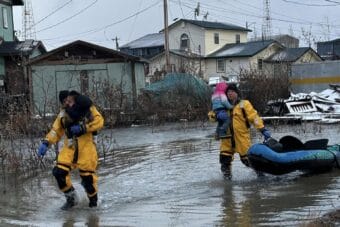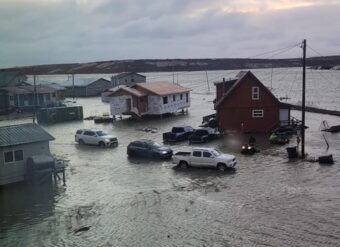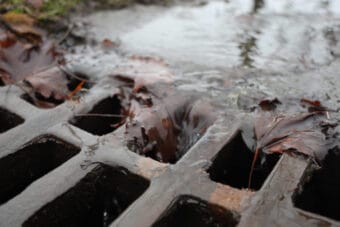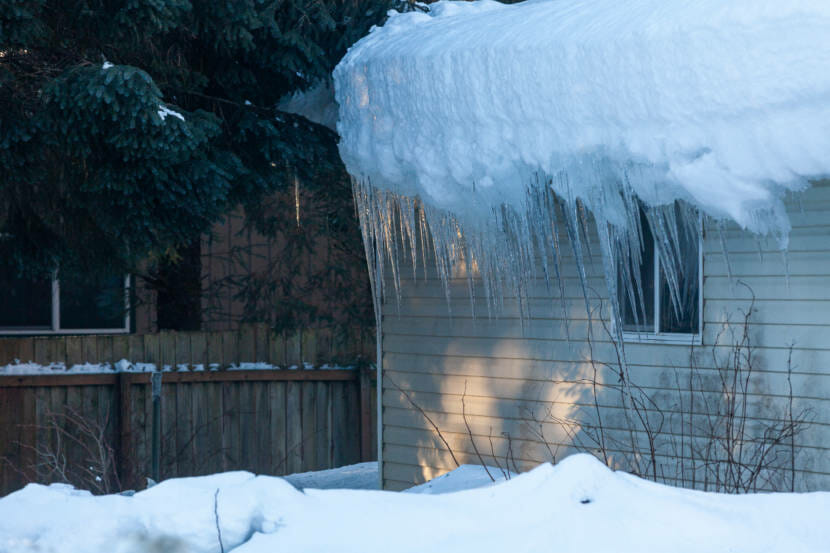
Winter weather is in full effect across Alaska, but unusually high snow accumulation is testing Southeast. Usually some snow melts between storms, but that’s not happening this winter.
Long icicles dangled under a block of snow piled on top of Stan Savland’s home in Juneau’s Lemon Creek neighborhood. Savland and his son knocked a piano-sized chunk of snow and ice off the roof with a steel bar this week.
Savland says warming from the attic created an ice dam that blocked the snow from sliding off his metal roof. He estimates more than three feet of ice and snow teetered above his fuel tank. So he took matters into his own hands.
“We put some protection by the oil tank, and it basically bounced off the protection and then bounced out, hit me in the leg and knocked me down,” he said. “We accomplished our goal but kind of got caught in the crossfire.”
Savland brushed off concern about his injury but was noticeably limping. Now he advises caution if you have a dangerous amount of snow. He says anything that can keep you off the roof is probably a good idea — like a snow rake. He’s also seen roofers advertising snow removal.
“I think they said like 50 cents a square foot. So 1000 square feet would be 500 bucks to clear a roof, but could be well worth it. I mean we’re expecting warming temperatures and more snow which is going to create more weight,” he said.
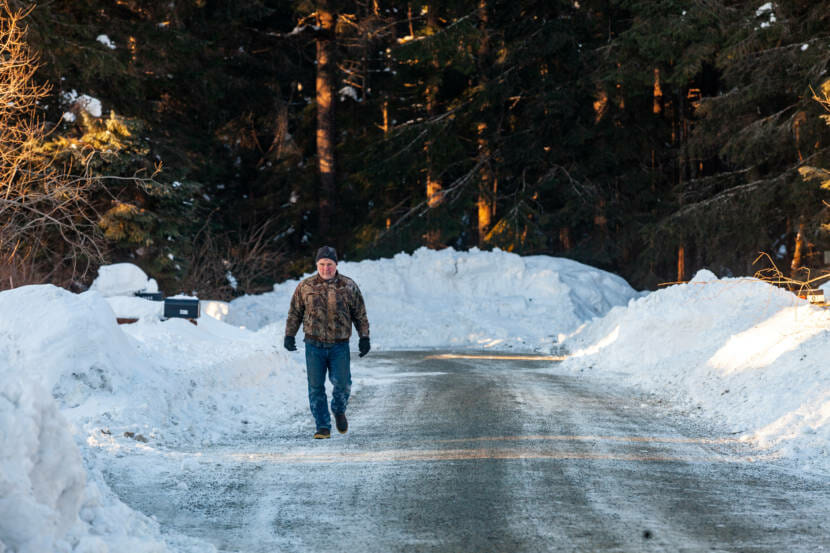
Down the road in Mendenhall Valley, friends and neighbors started calling Nate Geary to ask about the weight of the snow load on their houses. He’s an engineer for the state. Since he has the safety equipment on hand, Geary scaled his roof and cut out a one-foot block of snow.
“I just put that into a container and weighed it on a bathroom scale,” he said.
The snow block from his roof weighed 42 pounds — getting pretty close to the limit of what his roof can support.
Geary’s block was nearly three feet thick. At that point, he recommends getting up there and shoveling it off if you can do it safely.
“At a minimum, I think people should use a snow rake to clear the overhangs of the roof since that’s the weakest part of the structure,” he said.
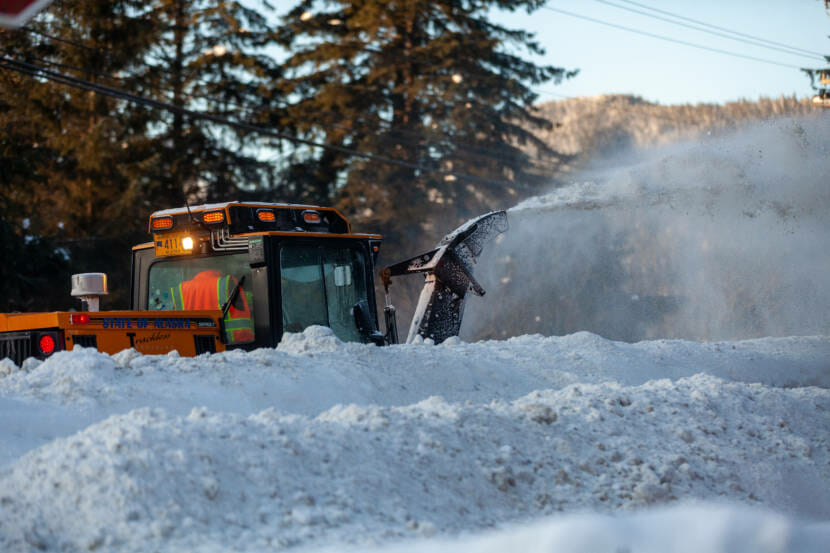
Juneau City Manager Rorie Watt says this has been the most intense pile-up in his three decades in Juneau. But he doesn’t want people to panic about snow on their rooftops.
“I would generally caution people to be careful and not overreact,” he said. “If they saw signs of flexing or cracking in the sheet rock, you know, then they might want to think about shoveling their roof off.”
He says if there’s signs the roof is taking too much weight, people might want to shovel it off, but he also worries about people getting up on their roofs in high winds and frigid temperatures.
Watt says city code is for roofs to withstand 50 pounds per square foot, but the old code was 40 pounds per square foot. He says most buildings were probably built to that lower rating.
Buildings with flat roofs are especially susceptible.
It’s not just Juneau laboring under heavy snow — Yakutat residents teamed up to clear the school roof this week. And as KHNS reports, the Haines’ Avalanche Center warned that local snowpack weighed up to 57 pounds per foot and could crush structures.
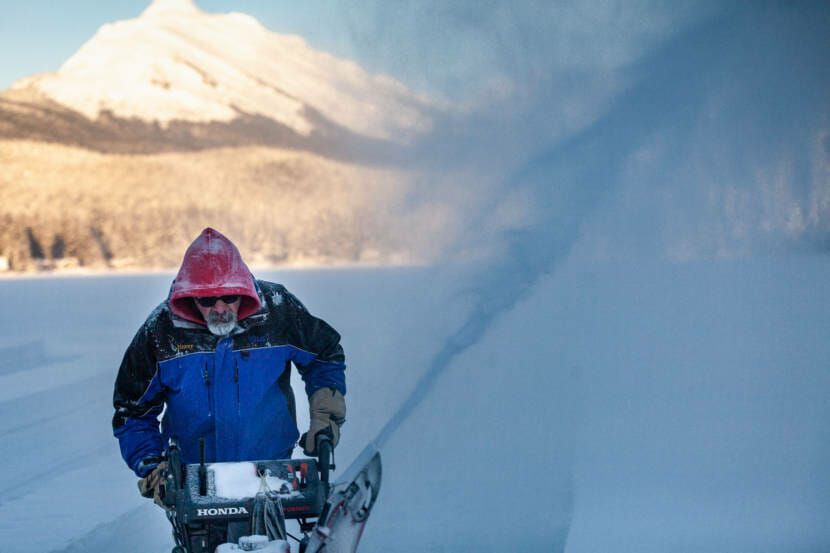
National Weather Service meteorologist Greg Spann says this isn’t the snowiest winter Southeast Alaska has ever seen, though snow accumulations at the Juneau airport are nearly double the average for this time of year.
“What’s made this winter in part stand out in so many places, is that the snow hasn’t been able to melt after each system,” he said. “Eventually the all that accumulated snow starts to become a real problem and a real hassle.”
That’s what’s happening this week. Juneau is running out of snow storage downtown and has blown through its snow removal budget already, according to the borough.
Another significant snow storm is coming this weekend after several days of truly frigid temperatures. Spann says the good news is that temperatures may bounce back up above freezing after that.
But more snow and warming temperatures could add even more weight on rooftops.
Rashah McChesney contributed to this story.
